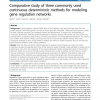Free Online Productivity Tools
i2Speak
i2Symbol
i2OCR
iTex2Img
iWeb2Print
iWeb2Shot
i2Type
iPdf2Split
iPdf2Merge
i2Bopomofo
i2Arabic
i2Style
i2Image
i2PDF
iLatex2Rtf
Sci2ools
116
Voted
BMCBI
2010
2010
Comparative study of three commonly used continuous deterministic methods for modeling gene regulation networks
Background: A gene-regulatory network (GRN) refers to DNA segments that interact through their RNA and protein products and thereby govern the rates at which genes are transcribed. Creating accurate dynamic models of GRNs is gaining importance in biomedical research and development. To improve our understanding of continuous deterministic modeling methods employed to construct dynamic GRN models, we have carried out a comprehensive comparative study of three commonly used systems of ordinary differential equations: The S-system (SS), artificial neural networks (ANNs), and the general rate law of transcription (GRLOT) method. These were thoroughly evaluated in terms of their ability to replicate the reference models' regulatory structure and dynamic gene expression behavior under varying conditions. Results: While the ANN and GRLOT methods appeared to produce robust models even when the model parameters deviated considerably from those of the reference models, SS-based models exhi...
Related Content
| Added | 08 Dec 2010 |
| Updated | 08 Dec 2010 |
| Type | Journal |
| Year | 2010 |
| Where | BMCBI |
| Authors | Martin T. Swain, Johannes J. Mandel, Werner Dubitzky |
Comments (0)

